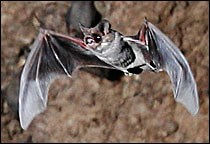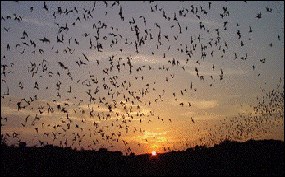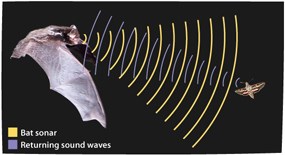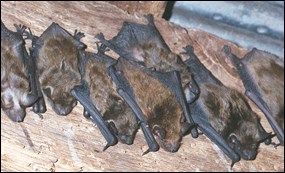
Photo © Hank and Marsha Rhodes 
Photo courtesy of the State of Florida Bats make up about one fifth of all mammal species on Earth. More than 1,200 species of bats exist, ranging from the world's smallest mammal — the tiny bumblebee bat that weighs less than a penny — to giant flying foxes with a six-foot wingspan. Florida is home to 13 species of bats that are either year-round or seasonal residents, and each of these species is insectivorous, which is another way to say that they eat insects. Several other species are considered accidental, meaning that they have on occasion been found in Florida, but they do not normally live here. The accidental species from the north are insectivorous, but those from tropical regions that have been found only in south Florida and the Florida Keys feed on nectar, pollen, and fruit, instead of insects. Everglades National Park is home to five bat species:

Photo courtesy of U.S. Geological Survey Because bats are nocturnal, which means they are active at night, few people see them, and even fewer people understand the importance of the ecosystem services they provide. Ecosystem services are the benefits obtained from the environment that increase human well-being. Bats are efficient controllers of insect populations, play an active role in seed dispersal, and pollinate many species of plants. Nectar feeding bats pollinate many plants that are valuable to humans, including banana, avocado, and mango trees. Even bat droppings, called guano, are valuable as a rich natural fertilizer. 
Graphic courtesy of ASU Ask a Biologist Bats use echolocation to navigate and find food in the dark. Echolocation is the use of sound waves and echoes to determine where objects are in space. Bats send out sound waves from their mouth or nose. When the sound waves hit an object, they produce echoes. The echoes bounce off the objects and return to the bats ears. The bats listen to the echoes to figure out where the object is, how big it is, and its shape. Using echolocation, bats can detect objects as thin as a human hair in complete darkness. The sounds that bats emit are called ultrasound. Also known as ultrasonic sound, ultrasound is an oscillating sound pressure wave with a frequency greater than the upper limit of the human hearing range. Frequency, sometimes referred to as pitch, is the number of times per second that a sound pressure wave repeats itself. The units of frequency, or pitch, are called hertz (Hz). Humans with normal hearing can hear sounds from about 20 to 20,000 Hz, although we lose the highest frequencies as we age. Frequencies above 20,000 Hz are known as ultrasound. A dog tilting its head to listen to some seemingly imaginary sound is tuning into ultrasonic frequencies as high as 45,000 Hz. Bats can hear at among the highest frequencies of any mammal, as high as 120,000 Hz. Bats emit and receive ultrasonic sound waves for echolocation as sonar, in order to locate and identify objects without the benefit of light. By emitting ultrasounds into the environment and listening to the echoes that return, bats can navigate through total darkness while they simultaneously forage for food. Echolocation allows bats to occupy a nighttime niche that offers many insects for food, less competition for those insects from other species, and fewer species preying on themselves as a food source. Bats also use ultrasound to communicate with each other. 
Photo courtesy of the State of Florida Bats leak information about themselves into the environment because the ultrasonic sound waves they emit contain information about their habitat and foraging niches as well as species-specific characteristics. Enormous potential exists for using ultrasound as a tool to globally monitor bat abundance, the status of their populations, and geographic distributions. 
NPS photo Click on the link to the audio file below to hear the echolocation calls of a Seminole bat that were recorded by a bat detector at Pa-hay-okee. The requested video is no longer available.

NEVER handle bats without the assistance of a permitted professional. The bats in the above photo are being rehabilitated for release into the wild. Photo © Hank and Marsha Rhodes Support Bat Conservation! For more information on bats and bat conservation, please visit:
|
Last updated: February 18, 2025
